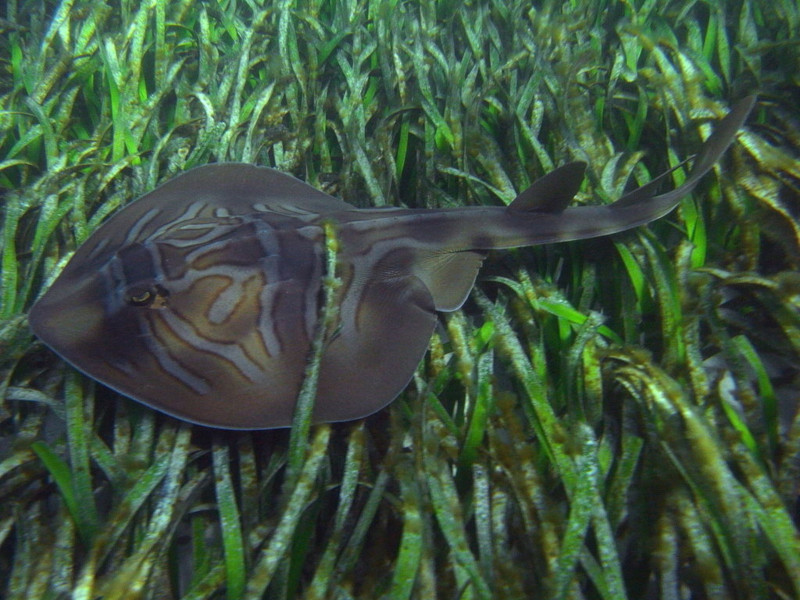
Fiddler Ray Facts
- The somewhat distinctive common name of Fiddler Ray actually applies to either of two species within the genus Trygonorrhina. The two remarkable species therein also occasionally go by the distinctive alternate common name of the banjo ray.
- Wholly regardless of the term one uses, though, the small genus in fact represents a variety of guitarfish. Quite uncommonly, both of these closely related species inhabit the same general area of the world. That’s something of a surprise to many.
- Although not completely unknown, such close association between two such similar species nevertheless remains surprising. Also quite uncommonly, the IUCN presently lists both types of Fiddler Ray as Species of Least Concern on its Red List.
- The remarkable creature further holds this pleasantly surprising present status on that list due to a highly surprising situation. That situation occurs because of the fact that its population appears to be relatively stable, at least for the moment.
- Sadly, the fascinating type of ray does face the potential threat of climate change, however, which currently looms over most species. Much like many related creatures, the beautiful Fiddler Ray also typically has a remarkably calm demeanor.
- In point of fact, individuals often openly approach divers. Fortunately, the fabulous animal is not actively commercially fished. Both species, though, do occasionally fall prey to recreational fishing, and accidental bycatch in trawling activities.
Related Articles
Porcupine Ray Giant Manta Ray Cownose Ray
Fiddler Ray Physical Description
Perhaps most notably, the pectoral fins of the gorgeous Fiddler Ray develop a slightly different appearance than those of its numerous related species. That’s because the body appears more rounded and shorter than those of other varieties of guitarfish.
Unlike some similar creatures found throughout the world, however, this animal does not display any noticeable degree of the trait of sexual dimorphism. Due to this surprising fact, mature adults of both genders attain an average length of about 3.9 ft (1.2 m).
This ray further displays pectoral fins that develop slightly more rounded and shorter than similar rays. this fascinating fish also displays an almost translucent snout, the reason for which currently remains unknown. The tails also grow quite long and slender.
Quite remarkably, its nasal flaps actually connect to the small mouth. This action Nature accomplished via the development of shallow grooves. Meanwhile, the mouth of the animal itself grows straight and narrow, and with many small, comparatively blunt teeth.
The eyes of the breathtaking Fiddler Ray, though, remain extremely small in relation to body size. Not surprisingly, its eyesight typically appears to be quite poor. Its coloring additionally generally displays as a light brown, with patches of widely varying shades.
- Kingdom: Animalia
- Phylum: Chordata
- Class: Chondrichthyes
- Order: Rajiformes
- Family: Rhinobatidae
- Genus: Trygonorrhina
Fiddler Ray Distribution, Habitat, and Ecology
Both of the impressive species collectively known by the term Fiddler Ray inhabit a relatively small habitat range of the globe. This natural territory further consists of two distinctly separate sections of ocean occurring along the coast of the continent of Australia.
Even more specifically, the two endemic ranges are sharply divided between the southern and eastern areas of coastline. In both regions in which it appears, the fish seems to live as a primarily benthic species. However, the two forms inhabit slightly different depths.
Firstly, the southern variety most commonly inhabits depths measuring up to 590 ft (180 m) in depth. Meanwhile, the form living along the eastern section of the coast typically only inhabits depths of up to 394 ft (120 m). The reason for this remains undetermined.
In both regions, the Fiddler Ray displays decided preferences for the type of area it chooses to live in. That’s because it most commonly lives in one of three particular types of habitat. These preferred areas consist of either rocky reefs, shallow, sandy bays, or beds of seagrass.
In fact, very few specimens have been observed inhabiting any other type of region. This animal also evolved as a bottom feeder. Not surprisingly, its principal prey consists of crabs, shellfish, and worms. These it crushes between its powerful jaws before swallowing.
The eastern member of the amazing genus has also been known to attack fish traps, to scavenge what they have trapped. Finally, the Fiddler Ray also evolved as ovoviviparous in nature. Breeding cycles typically produce litters of either four or six young.
Species Sharing Its Range
Dugong Australian Ghost Shark Spotted Handfish
Check out our other articles on 5 Amazing Galapagos Islands Species, Greater Sage Grouse, Devils Kettle Falls, Bois Dentelle, Gambian Spotted-Eye Flower Mantis, Polar Bear
